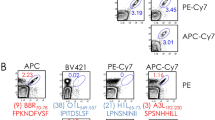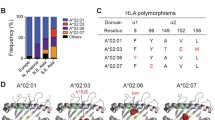Abstract
Limit-dilution cultures were used to select vaccinia-immune T-cell populations from bml and bm3 mutant mice that were not lytic for virus-infected targets expressing the Kb and Db MHC glycoprotein. Approximately 30% of virus-immune CTL were restricted in each case to Kbm1 and Kbm3, rather than to Db. Evidence of extensive cross-reactivity was found for these virus-immune CTL. Bm3 and bmll mice sharing one amino acid mutation from wild-type but differing by a second mutation seen only in bm3 are the most cross-reactive pair in their presentation of vaccinia. The bm1 and bm10 pair with dissimilar mutations from wild-type affecting the same CNBr fragment are also largely cross-reactive. However, 30% cross-reactivity is also found for bm1 and bm3, which differ in separate CNBr fragments. That mutants expressing amino acid substitutions in the same region of the peptide tend to show more evidence of cross-reactivity does not necessarily mean the T cells see linear arrays of amino acids on the MHC glycoprotein. For instance, Kbm1 and Kbm10 differ for three amino acids, but bm1 T cells are highly lytic for bm10 virus-infected targets. However, there is no cross-reactivity for Kbm1 and Kb, which differ at only two amino acids. The key to further understanding may rest with defining the nature of the conformational differences among the Kbm1, Kbm10, and Kb glycoproteins.
Similar content being viewed by others
Abbreviations
- MHC:
-
major histocompatibility complex
- CTL:
-
cytotoxic T lymphocytes
- CML:
-
cell-mediated lympholysis
- PFU:
-
plaque-forming units
- UV:
-
ultraviolet
- SR:
-
spontaneous release
- MR:
-
maximum release
- FCS:
-
fetal calf serum
- CNBr:
-
cyanogen bromide
References
Allouche, M., Owen, J. A., and Doherty, P. C.: Limit dilution analysis of weak influenza-immune T cell responses associated with H-2Kb and H-2Db. J. Immunol. 129: 689–693, 1982
Andrewes, C. H. and Pereira, H. G.: Viruses of Vertebrates, Williams and Wilkins Co., Baltimore, 1967 Wilkins Co., Baltimore, 1967
Benacerraf, B.: A hypothesis to relate the specificity of T lymphocytes and the activity of I region-specific It genes in macrophages and B lymphocytes. J. Immunol. 120: 1809–1812, 1978
Bennink, J. R., Yewdell, J. W., and Gerhard, W.: A viral polymerase involved in recognition of influenza virus-infected cells by a cytotoxic T cell clone. Nature 296: 75–76, 1982
Blanden, R. V., Dunlop, M. B. C. P. C., Kohn, H. I., and McKenzie, I. F. C.: Effects of four H-2K mutations on virus-induced antigens recognized by cytotoxic T cells. Immunogenetics 3: 541–548, 1976
Braciale, T. J., Andrew, M. E., and Braciale, V. L.: Heterogeneity and specificity of cloned lines of influenza-virus-specific cytotoxic T lymphocytes. J. Exp. Med. 153: 910–923, 1981
Doherty, P. C.: Surveillance of self: cell-mediated immunity to virally modified cell surface is defined operationally by the major histocompatibility complex. In J. Dausset and Y. Fougereau (eds.): Proceedings of the Fourth International Congress of Immunology, p. 563, Academic Press, New York, 1980
Doherty, P. C. and Zinkernagel, R. M.: A biological role for the major histocompatibility antigens. Lancet 1: 1406–1409, 1975
Doherty, P. C., Götze, D., Trinchieri, G., and Zinkernagel, R. M.: Models for recognition of virally modified cells by immune thymus-derived lymphocytes. Immunogenetics 3: 517–524, 1976
Doherty, P. C., Bennink, J. R., and Wettstein, P. J.: Cross-stimulation of negatively selected H-2bm1 and H-2b T cells with vaccinia virus shows complete discrimination between mutant and wild-type H-2K alleles. J. Immunol. 126: 131–133, 1981
Doherty, P. C., Biddison, W. E., Bennink, J. R., and Knowles, B. B.: Cytotoxic T cell responses in mice infected with influenza and vaccinia viruses vary in magnitude with H-2 genotype. J. Exp. Med. 148: 534–543, 1978
Klein, J.: H-2 mutations: their genetics and effect on immune functions. Adv. Immunol. 26: 55–146, 1978
Melief, C. J. M., DeWaal, L. P., VanDerMeulen, M. Y., Melvold, R. W., and Kohn, H. I.: Fine specificity of alloimmune cytotoxic T lymphocytes directed against H-2K. A study with Kb mutants. J. Exp. Med. 151: 993–1013, 1980
Melvold, R. W. and Kohn, H. I.: Eight new histocompatibility mutations associated with the H-2 complex. Immunogenetics 3: 185–191, 1976
Nairn, R., Yamaga, K., and Nathenson, S. G.: Biochemistry of the gene products from murine MHC mutants. Anna. Rev. Genet 14: 241–277, 1980
Owen, J. A., Allouche, M., and Doherty, P. C.: Limiting dilution analysis of the specificity of influenzaimmune cytotoxic T cells. Cell. Immunol. 67: 49–59, 1982
Pan, S. H., Wettstein, P. J., and Knowles, B. B.: H-2Kb mutations limit the CTL response to SV40 TASA. J. Immunol. 128: 243–246, 1982
Ryser, J. E. and MacDonald, H. R.: Limiting dilution analysis of alloantigen reactive T lymphocytes. J. Immunol. 122: 1691–1696, 1979
Sherman, L. A.: Influence of the major histocompatibility complex on the repertoire of allospecific cytolytic T lymphocytes. J. Exp. Med. 155: 380–389, 1982
Wettstein, P. J.: H-2 effects on cell-cell interactions in the response to single non-H-2 alloantigens. V. Effects of H-2Kb mutations on presentation of H-4 and H-3 alloantigens. J. Immunol. 128: 2629–2633, 1982
Zinkernagel, R. M.: H-2 compatibility requirement for virus-specific T cell mediated cytolysis. The H-2K structure involved is coded by a single cistron defined by H-2Kb mutant mice. J. Exp. Med. 143: 437–443, 1976
Zinkernagel, R. M. and Doherty, P. C.: Immunological surveillance against altered self components by sensitized T lymphocytes in lymphocyte choriomeningitis. Nature 251: 547–548, 1974
Zinkernagel, R. M. and Doherty, P. C.: The concept that surveillance of self is mediated via the same set of genes that determines recognition of allogeneic cells. Cold Spring Harbor Symp. Quant. Biol. 41: 505–510, 1976
Zinkernagel, R. M. and Doherty, P. C.: MHC-restricted cytotoxic T cells: studies on the biological role of polymorphic major transplantation antigens determining T cell restriction specificity function and responsiveness. Adv. Immunol. 27: 51–177, 1979
Zinkernagel, R. M., Althage, A., Cooper, S., Kreeb, G., Klein, P. A., Sefton, B., Flaherty, L., Stimpfling, J., Shreffler, D., and Klein, J.: Ir genes in H-2 regulate generation of antiviral cytotoxic T cells. Mapping to K or D and dominance of unresponsiveness. J. Exp. Med. 148: 592–606, 1978a
Zinkernagel, R. M., Klein, P., and Klein, J.: Host-determined T cell fine specificity for self H-2 in radiation bone marrow chimeras of standard C57BL/6 (H-2b), mutant Hz1 (H-2ba) and Fl mice. Immunogenetics 7: 73–77, 1978b
Author information
Authors and Affiliations
Rights and permissions
About this article
Cite this article
Hurwitz, J.L., Pan, S., Wettstein, P.J. et al. Cross-reactivity patterns of vaccinia-specific cytotoxic T lymphocytes from H-2K bmutants. Immunogenetics 17, 79–87 (1983). https://doi.org/10.1007/BF00364291
Received:
Revised:
Issue Date:
DOI: https://doi.org/10.1007/BF00364291




